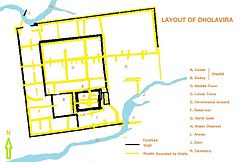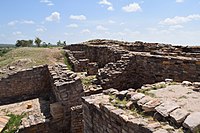Ancient Indian architecture
Ancient Indian architecture is the architecture of the Indian subcontinent from the Indian Bronze Age to around 800 CE. By this endpoint Buddhism in India had greatly declined, and Hinduism was predominant, and religious and secular building styles had taken on forms, with great regional variation, which they largely retained until and beyond the great changes brought about by the arrival of first Islam, and then Europeans.
Much early Indian architecture was in wood, which has almost always decayed or burnt, or brick, which has often been taken away for re-use. The large amount of Indian rock-cut architecture, essentially beginning around 250 BCE, is therefore especially important, as much of it clearly adapts forms from contemporary constructed buildings of which no examples remain. There are also a number of important sites where the floor-plan has survived to be excavated, but the upper parts of structures have vanished.
In the Bronze Age the first cities emerged in the Indus Valley Civilization. Archaeology has unearthed urbanization phase from early Harappan in Kalibangan to the late Harappan phase when urbanization declined but was preserved in few pockets. The urbanization in the Gangetic plains began as early as 1200 BC with the emergence of fortified cities and appearance of Northern Black polished ware."[2][a][4] The Mahajanapada period was characterized by Indian coins and use of stone in the Indian architecture. The Mauryan period is considered as the beginning of the classical period of Indian architecture. Nagara and Dravidian architectural styles developed in the early medieval period with the rise of Hindu revivalism and predominant role of Hindu temple architecture in the Indian Subcontinent.
Bronze age period (3300 BCE–1300 BCE)
Early Harappan phase
Although the urban phase of Harappa has been dated back to 2600 BC, excavation at Kalibangan from the early or proto-Harappan period already shows an urban development with fortification, grid layout of the city and drain system. The settlement consisted of a fortified city mostly made of mud-brick architecture but characterized by an appearance of fired bricks around 3000 BC which was used to line the drains of the city.
English Bond and building material
While in contemporary Bronze Age cultures outside India sun-dried mud bricks were the dominant building material, the Indus Valley civilization preferred to use fired "terracotta" brick instead. A prominent feature of Harappan architecture was also the first use anywhere in the world of English bond in building with bricks. This type of bonding utilized alternate headers and stretchers which is a stronger method of construction. Clay was usually used as cementing material but where better strength was needed, such as for the drains, lime and gypsum mortar was preferred instead. In architecture such as the Great Bath, bitumen was used for waterproofing. The Use of bitumen has been attested as early as the Mehrgarh period, one of the earliest uses in the world as well. The remarkable vertical alignment of the building indicates the use of a Plumb line. The bricks were produced in a standardized ratio of 4:2:1, found throughout the Indus Valley Civilization.[5]
Late Harappan period
After the collapse of the mature Harappan urban period, some cities still remained urban and inhabited. Sites like Bet Dwarka in Gujarat, Kudwala (38.1 hectares) in Cholistan and Daimabad (20 Ha) in Maharashtra are considered urban. Daimabad (2000-1000 BC) developed a fortification wall with bastions in its Jorwe culture period (1400-1000 BC) and had public buildings such as an elliptical temple, an apsidal temple and shows evidence of planning in the layout of rectangular houses and streets or lanes and planned streets. The area had rose to 50 hectares in with a population of 10,000 people. A 580-meter long protection wall dated 1500 BC was found at Bet Dwarka which is believed to have been damaged and submerged following a sea storm.[6][7]














Comments
Post a Comment